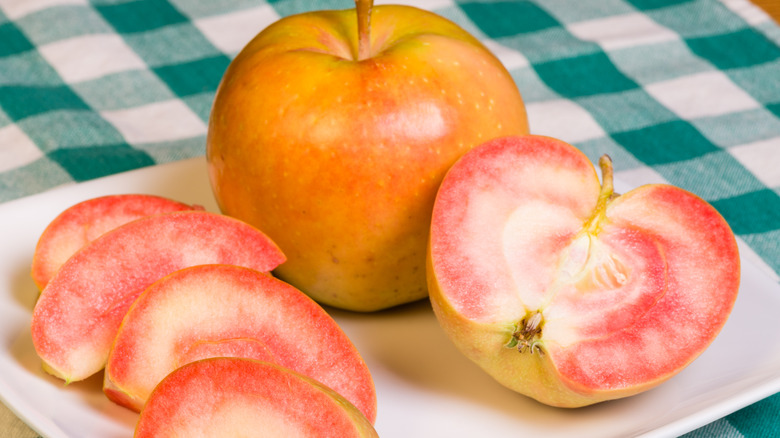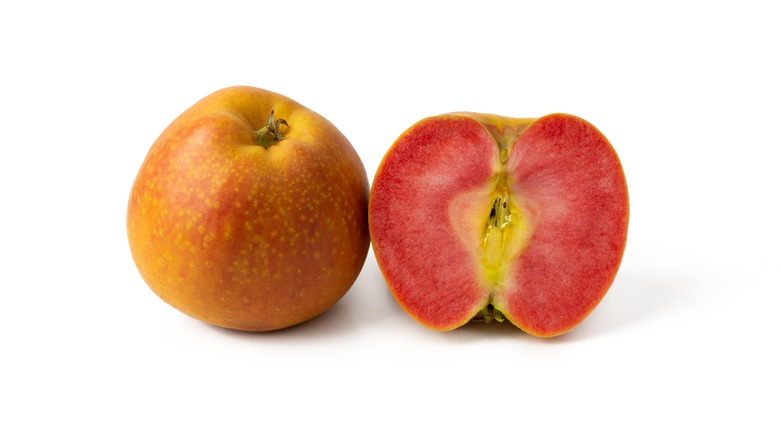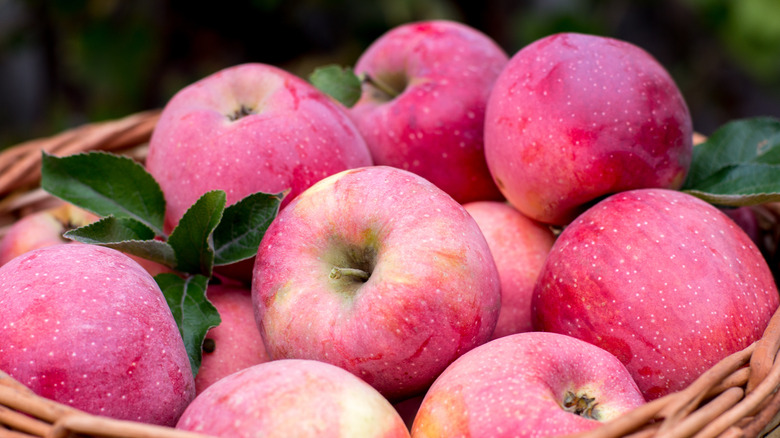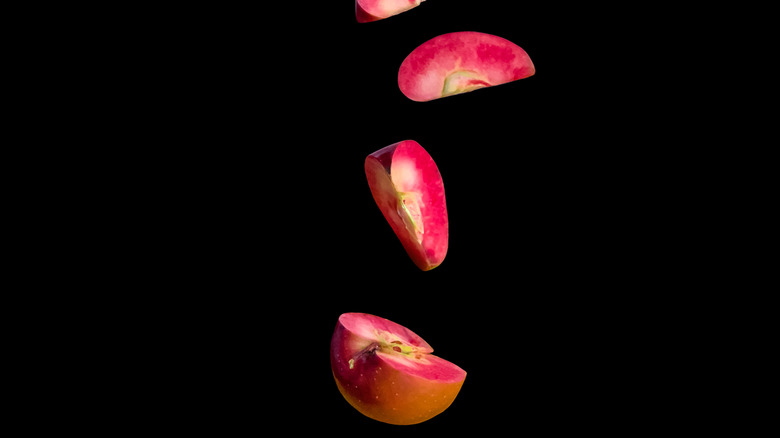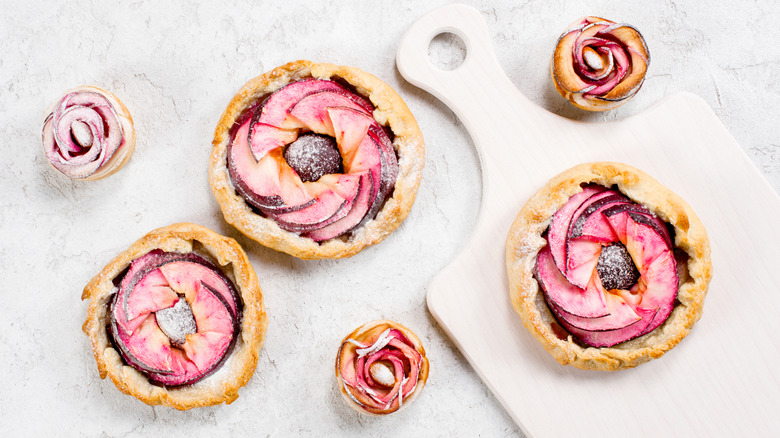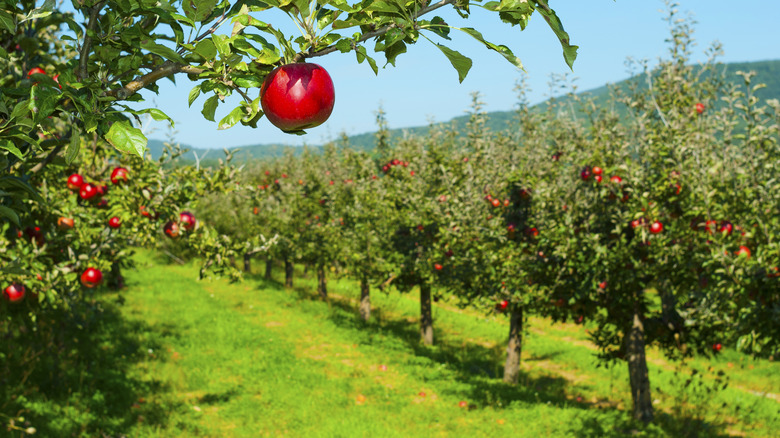The Native California Apple With A Bright Pink Center
Washington, the Evergreen State, may produce more apples than any other, with six out of every 10 apples coming from there, but don't sleep on West Virginia, Minnesota, or New York, as they grow the best Golden Delicious, Honeycrisp, and Cortland apples, respectively (via PureWow). And when you think of California, you may not think of apples, as they're instead top producers of grapes, almonds, and strawberries, according to the California Department of Food and Agriculture.
But as it turns out, there is one rare pink apple variety that is native to the Golden State. Known by its scientific name Malus domestica, the Pink Pearl apple is aptly named for its vibrant magenta hue, Planting Justice shares. When you first pick up a Pink Pearl apple, you may be confused, as the outside of these fruits are a yellow-green shade. But once you cut them open, you'll see the pretty interior, Atlas Obscura explains, hidden from outside view just like a pearl.
Let's take a look at where these rare pink beauties come from, what they're like, and what to eat them with.
What are Pink Pearl apples?
Pink Pearl apples are part of the Rosaceae family, which includes stone fruits, berries, and roses, and part of the maloideae subfamily, making them a close relative of pears (via Britannica). These medium-sized apples are yellow-green on the outside, similar to a golden delicious, and can range from bright pink to red on the inside, Specialty Produce shares. While fall is prime apple season for most varieties, Pink Pearl apples are unique in that they are harvested in the late summer through September, according to Trees of Antiquity.
These hot pink fruits also have a unique origin story, as they were developed by fruit breeder Albert Etter. Known primarily for his experiments with apples and strawberries, Etter created the Pink Pearl apple in 1944 in northern California, Eco Landscaping shares, primarily from the Turkish pink surprise apples. However, the Pink Pearl wasn't his only apple, as Etter bred hundreds of types from the surprise apple, creating around 15,000 in his lifetime (via The Daily Gardener). After the Pink Pearl apple was presented to the California Nursery Company, according to Minnetonka Orchards, it was properly named and patented in 1945.
Pink pearl apples vs. Pink lady apples
While Pink Lady and Pink Pearl apples have similar names, you wouldn't typically mistake them for each other at the grocery store. While they are both named for their pretty rosy hue, Pink Lady apples are reddish-pink on the outside, while Pink Pearl apples hide their blush color on the inside. However, these two fruits were both created by apple breeders in the 1900s — Pink Pearls in California, and Pink Ladies in Australia by John Cripps, who crossbred a golden delicious with a red Australian apple called a Lady Williams in the 1970s (via Stemilt). The technical name for the apples is Cripps Pink, but today they're sold under the trademark Pink Lady, according to Orange Pippin.
While Pink Pearls thrive in the warmer, late summer months, Pink Lady Apples explains that Pink Ladies enjoy a lengthy, 200-day growing season. And while Pink Pearls are mostly found in California, Pink Ladies are mostly grown in Washington in the U.S., although they can also be seen in Europe, South America, Australia, and other regions (via Specialty Produce).
What do Pink Pearl apples taste like?
According to Specialty Produce, the rosy Pink Pearls have subtle flavors of raspberry and grapefruit, and a strong aroma. The harvest time of Pink Pearls determines where on the scale of tart to sweet-tart they will be, according to Trees of Antiquity. And despite their other differences, Pink Pearls have a fairly similar taste to Pink Lady apples. According to Stemilt, Pink Ladies are also sweet and tart, although they are a little more crisp and refreshing than Pink Pearls. So in name and flavor, these two pink apples have a few things in common.
Pink Pearls get their flavor from their parent fruit, Surprise apples. Specialty Produce says Surprises have a similar sweet-tart juxtaposition, where apples harvested earlier are tarter, and ones picked later are sweeter. And although Surprise apples are more acidic than Pink Pearls, they become sweeter and softer after a couple of weeks, Orange Pippin explains.
How to cook with Pink Pearl apples
Due to the range of flavors and beautiful inner appearance of Pink Pearl apples, there are a ton of ways to use these fruits. Cutting them up and throwing them in salads is a popular way to display Pink Pearls, and they add a tart crunch, according to Parade. They also work well when made into applesauce, producing a uniquely flavored, bright pink sauce, Minnetonka Orchards shares. And if you're looking to bring a little tang to your baked goods, try incorporating Pink Pearl apples into cobblers, pies, cookies, apple dumplings, and more.
While most fruity desserts are easy on the eyes, Pink Pearl apples bring them to a whole different level. Take this Pink Pearl apple galette, for example, which is a vibrant pink work of art (via The Feed Feed). Or this Pink Pearl apple custard tart from Constellation Inspiration, in which the apples are transformed into beautiful pink roses. Don't worry if you're not an expert in arranging food, as the apples are so pretty they can do the work for you. In this Pink Pearl apple tart with spiced mascarpone honey cream, for instance, all you have to do is slice the apples and layer them in a simple pattern on the dough (via Sparkling Charm).
Aside from stunning desserts, Minnetonka Orchards notes you can make these apples into smoothies, pair them with pork or chicken salad, or just eat them plain for a juicy, delicious snack.
Where to buy Pink Pearl apples
If you live in California, Oregon, or Washington, it should be pretty easy to get your hands on Pink Pearl apples when in season. According to Specialty Produce, these fruits are primarily grown in these states, although you may have to take a trip to the orchards themselves to buy them. You may have luck at farmer's markets on the West Coast as well. Because of their brief harvest season and specific growing area, like the gem that bears their name, Pink Pearls can be pretty hard to find beyond this area of the U.S. Kroger may have them in stock at times, and they have been seen at grocery chain Lazy Acres, according to Beyond Sweet and Savory.
If you're so inclined, you might have better luck buying the trees online and planting them yourself. Sites like Planting Justice, Raintree Nursery, and Burnt Ridge Nursery sell Pink Pearl apple trees and provide instructions to grow them. If you do love to garden, these trees might make a nice addition to your collection, as Minnetonka Orchards notes, they also have pretty pink flowers.
Once you do get your hands on the elusive Pink Pearl, take note that they go bad pretty quickly, so you'll want to eat or cook them right away (via Trees of Antiquity).
Nutritional information about Pink Pearl apples
We know that an apple a day keeps the doctor away. But what do Pink Pearl apples specifically bring to the table? According to Specialty Produce, these fruits have a good amount of vitamins A, B, and C, as well as pectin, a dietary fiber. They're pretty low in calories, with only about 55 per apple, and have small amounts of calcium, magnesium, and potassium — and we mean small, as the latter nutrients in one apple each make up 3% or less of your daily recommended value (via Kroger).
However, just like any apple, Pink Pearls are overall a very healthy food. According to Fit For the Soul, they're a hydrating fruit due to their high water content, and they have a small amount of boron, which can help build strong bones. Best Health Mag shares that apples can help reduce the risk of cancer, Alzheimer's, diabetes, and high cholesterol, and they can even help your teeth stay white by reducing tooth decay.
To get the most out of your Pink Pearl apples, don't peel them before eating, as two-thirds of the apple's fiber and antioxidants lie in their skin (via WebMD).
